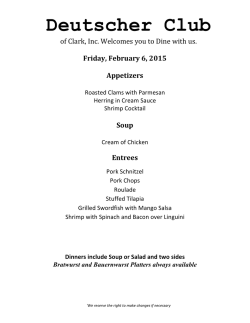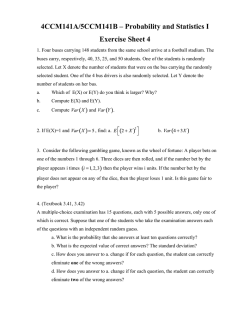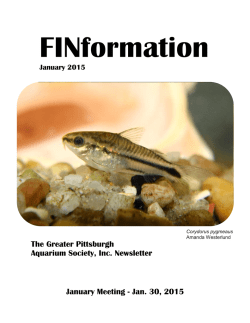
The January issue of The Cichlid Chronicles
The CCY is back “Year 3”!! I can promise to everyone is that this year will be one of structure and building upon the foundation created over the last 2 years. Our calendar is set with all speakers locked in for the entire year! Never before have we had the luxury to say this. By laws are in place, our non profit status is close to complete. We are very focused this year to establish and promote our BAP (Breeders Award Program) and our C.A.R.E.S programs. We are also very excited about the 3rd edition of our “Clash of the Cichlids” show. This event has become a CCY staple that clubs from around the surrounding area look forward to attending. This year I am proud to announce that Mo Devlin will be our guest speaker for the show! I am also very excited about next months Aqua mania “The Big Fish Deal 3”. The CCY has attended this great event every year and this year will be no different! So buckle up everyone this year is promised to be a GREAT ONE!!! - Scott McLaughlin With all due respect to every other convention and club function around the United States, there is no other “cichlid focused” event I enjoy more than Aqua mania! Now obviously the ACA American Cichlid Association Conference is near and dear to my heart (the 2011 conference in Washington DC was life changing for me), but with it changing from state to state and city to city each year its not an event I can attend regularly. Hosted by our sister club The CCA - Capital Cichlid Association, “Aqua mania the Big Fish Deal” takes place in Gaithersburg MD Feb 27-March 1st 2015. Aqua mania is such a large part of the CCY way of life that we actually shut down for the month of February so that we can take part and enjoy in the Aqua mania event. Located a little over 1 hr away, Aqua mania each year supports a lineup of great speakers, fun filled events, silent auctions with rare cichlids and my favorite “The Sunday Marketplace”. The CCA was smart and insightful enough to understand that although “auctions’ are great, they due tend to run long and buyers may have to wait hours to get to a bag of cichlids they want to bid on. The marketplace solves all that issue by allowing sellers to set up tables and sell cichlids direct to the Aqua mania attendees. Add to it that attendees of the entire event get early bird privileges where they can scan all the tables of goodies before its open to the public and you have one great day of cichlid power buying!!! The CCY has attended the last 2 Aqua mania events and each year we bring more CCY members with us, this year will be no different. So if you are looking for your first big event to attend than read on as I give you my personal tips of what you need to bring to have a successful experience. With Aqua mania just around the corner I think this would be a good time to talk about what to bring to have a successful experience. Aqua mania always has the best speakers in the hobby and this year will be no exception. Which brings us to “must have” #1– Paper and pencil. These speaking engagements are very informative so you want to make sure you soak up every morsel of information possible. Video recording the speakers is not allowed so its imperative that you have either paper and pencil or some sort of phone, tablet or laptop where you can record notes. Last year one of my cichlid idols Rusty Wessel spoke and I was so excited about hearing him speak I forgot to bring something along to take notes with. Well never again my friends. This guy will have paper and pencil and tablet in hand! 2nd– Dress warmly! February is always cold and although we all want to show off our favorite and latest club affiliated T shirts it’s important to keep warm. Last year I had to fight a terrible cold that kept me from enjoying one of the best Aqua mania event that being the “rare silent auction”. The conference rooms are well heated so no issues there but running in and out of the hotel will be the time to be cautious. Pack sweaters and dress warm people! 3rd– Don’t be shy- say “Hello”! Be friendly and open to meeting new and exciting people. Matt Quinn of the CCA took the time to sit down, speak to me at the very 1st Aqua mania event. 3 years later Matt and I are good friends and he has done 2 presentations for the CCY. We are also in talks about a doing a collecting trip in the near future. Fish people are the very best of people. They are always friendly, honest and wanting to help. So let down your guards people, put a smile on your face and introduce yourself. You may meet a lifetime friend! Fish, fish and more fish! #4– Have a mobile hotel friendly home for your new cichlid purchases– Ok we are getting into the fun stuff now! One of the greatest parts of Aqua mania is the abundant amount of cichlids available all day every day at this event. There is the market place, the silent rare cichlid auction and then hotel rooms full of cichlids just waiting to be purchased “under the cover of night”. So with all this said you need to have the right tools and supplies to keep your new purchases healthy and happy for its 2-3 day hotel stay. My first Aqua mania experience I was ill prepared for all the things needed to keep my cichlid purchases overnight. Luckily I had a tank setup in the Aquarium Beautiful contest and was able to put my purchases in that tank. The 2nd year Mike Mull and I roomed together and I got to see first hand how its done. Here are the items Mike used to properly house his newly purchased cichlids. Battery operated air pump, heater, large plastic containers (used as a temporary tank) and stress coat/prime to condition the water. Below is a picture taken by CCA guru Pat Kelly of his hotel room setup using the same tools. I can’t tell you how cool it is to go from room to room and see the elaborate setups prepared by various fish lovers. So after checking in one of the first things everyone does is setup their plastic containers with water. They then condition them and add heaters and air pumps with sponge filters. By the time you have enjoyed the first speaker or two, your mobile fish room will be cycled and ready to house those awesome cichlids. This concludes my brief outline of what you need for Aqua mania. Now get yourself prepared for a great time you won’t soon forget!! Image of Pat Kelly’s hotel Orlando and I enjoying a happy Sunday Aqua mania Market Place Wayne Leibel Being able to successfully teach on any level is a “gift”. You see anyone can throw information at you in an effort to educate and inform you. But it’s truly an “artist” who can break down raw knowledge into easily digestible nuggets and make it enjoyable plus taste good! Like Robin Williams in the movie Dead Poet Society -Wayne Leibel is a gifted teacher or “mind expander” whose skills to teach whether its Biology, music or cichlids is unmatched. He is genuine, he has a sharp sense of humor and he motivates. I left the ACLC/ CCY dual meeting last October feeling very motivated by Wayne’s presentation. I left feeling a sense of responsibility (especially as a lover of New World Cichlids) to continue down the path Wayne has started; promoting, recruiting and educating others on the cichlids of the Americas. When I entered the hobby of cichlid keeping one of the first things I did was read all I could to give myself the best preparation for success. “Wayne’s New World” “Cichlids of the Americas” was a great article I got the privilege to read that inspired me to keep the cichlids I have currently in my tanks. I was never a huge fan of African cichlids and to read Wayne’s quote about African cichlids made me laugh loudly and champion Wayne instantly. He said: (from Wayne’s New World – Goin’ South part 01 Cichlids of the Americas) --------------------------------------------------------------------------------------------------------------“African cichlids may be beautiful, but they're dumb! Nothing more than aggressive, expensive tetras! And pretentious tetras at that. (Okay, Cyphotilapia frontosa is an exception.)” It was truly an honor to finally meet Wayne at our October meeting. Having the ability to reach out to him and ask questions is priceless. It gives me great pleasure to sit down with Wayne today and ask him a few questions about teaching, his love for cichlids and his keys to success. So without further ado I present – WAYNE LEIBEL: 1. Wayne, when I “Googled” your name to do some more research on you; several pictures came up. Many of the pictures were with you, your students and your incredible tanks. Do you have tanks on the Lafayette Campus and how often does your love for cichlids intermix with how or what you teach your students about life? I have kept fish for most of my life, nearly 60 years of fish and counting! Strangely, my biology degree and teaching was not in the field of ichthyology or fisheries, rather in cell and molecular biology. But rather than seeking a position at a research university, I purposefully elected to teach at a small, exclusively undergraduate college, Lafayette College in Easton PA. There, I taught molecular biology, developmental biology and genetics. While we are expected to do some research, the job is mostly about teaching. This gave me plenty of time to develop a ‘second career’ if you will, in the organized hobby. I became very active (rather I, continued my activity) in the American Cichlid Association and also continued my regular writing for a variety of magazines including a long-running column in TFH, my series of South American Cichlid articles in AFM, and articles for Buntbarsche Bulletin and Cichlid News. More recently, I have been teaching Evolutionary Biology at Lafayette, and have worked in information about explosive speciation in the African Rift Lake cichlid clades. My research students have done some projects involving cichlids and mate choice. I have a small fish room at the College for that purpose, about 1000 gallons of mostly convict cichlids and some eartheaters, and a few other things. 2. Every story has a beginning so tell us about your first experience with keeping fish and then more importantly tell us where and when your passion for cichlids of the Americas began? I saw a tank of kribensis, Pelvicachromis pulcher, in a pet shop and was taken with their coloration and behavior: the females were courting the males and doing their ‘belly dance’. And the pairs were defending their respective territories. I was allergic to fur and feathers, so my parents happily purchased a 15 gallon set up for me when I was about 6 years old and away we went. It was community tanks for many years: we got progressively better at it and slowly the one tank grew to several in the basement of our house. I gravitated towards cichlids because of their interesting behavior. I kept angelfish, convicts, kribensis and a few others. This was in the late 1950’s- early 1960’s. African Rift Lake cichlids had not yet made their huge impact on the hobby. The books of the day featured South and Central American cichlids and I was soon hooked on dwarf cichlids of the genus Apistogramma. I also got very interested in killifish and was seriously keeping them in the 1970’s along with the Apistos. Around 1980 I discovered the other, larger South American cichlids and began studying about and keeping them: eartheaters, acaras, pike cichlids, etc. 3. Tell us about your fish room, how many tanks you have and talk about some of your favorite cichlids that you are keeping. Well, I maintained a fishroom of about 2000 gallons, mainly larger tanks, for about a dozen years until c. 2004 when a disability interfered with my ability to keep up with them. I kept mostly South American cichlids. I was blessed with access to many rare cichlids thanks to two wholesalers, first Lombardo’s in Newark NJ, and more recently Jeff Rapps at Tangled Up in Cichlids, in Phillipsburg NJ, only 6 miles from my house. I was able to obtain and in several cases be the first one to spawn such cichlids as Acarichthys heckelii, the Threadfinned Acara, Acaronia nassa, the True Basketmouth, and Crenicichla marmorata, the marbled pike. I no longer have a basement fishroom, but I do maintain the aforementioned 1000 gallons at school where, in addition to convict cichlids for my students’ research, I am keeping three species of ‘Red Hump’ Eartheaters: ‘Geophagus’ steindachneri, ‘G.’ crassilabrus, and ‘G.’ pellegrini. I have a few smaller acara species as well, and was pleased to obtain and spawn recently (and distribute) the rare Heroina isonycterina. The largest tanks I have now are breeder 40’s and a pair of 55’s: mostly 20 longs and 10’s for the convicts. 4. At this point of your career is there anything you want to do that you haven’t done? Any places you want to see? Any newly discovered cichlids you are interested in keeping? A new book you want to write? I have been fortunate to travel to and collect in several South American countries including the Peruvian Amazon twice, the Venezuelan Orinoco twice, and the Brazilian Rio Negro. I also collected in Costa Rica. My hardcore traveling/collecting is over due to my walking disability, but I may be able to limp my way through Uruguay in the future: the country and cichlids are fascinating. These days we hobbyists are blessed with a seemingly unlimited supply of rare and properly identified cichlids. There will always be new species to acquire and to spawn. I am hoping to some day have a finished basement and a home fishroom again so I can get back to keeping these new and rare fish. 5. Lastly for those new guys and gals who have just been bitten by the cichlid keeping bug. What are some of your keys to success cichlid keeping and what cichlids would you recommend for the beginner? New World cichlids are among the most ‘industrial strength’ tropical fish there are. Aside from a few diseases, and damage inflicted as a result of their aggression which needs to be properly managed, they are undemanding in the aquarium (with certain ‘blackwater’ exceptions) with respect to water chemistry and, etc. Water quality is another matter, and can be easily managed by frequent water changes. The amount of information available online these days is staggering and I would encourage all hobbyists, both beginning and advanced to keep reading!!! Knowledge is the key to success! That and becoming active in local aquarium societies. As for good beginner’s cichlids, may I recommend the one that started my love affair? I think kribensis, Pelvicachromis pulcher, are a great starting point: they are colorful, behaviorally interesting, and easy to manage in smaller-sized tanks. They do well in mixed communities and planted tanks as well. Failing that, there’s always the underestimated convict cichlid! We want to thank you again Wayne for doing a presentation for the ACLC and CCY as well as answering questions here today. We look forward to a return visit from you and wish you continued success. Scott McLaughlin CCY President A Simple Way to Hatch Brine Shrimp by Jay Stephan Some time back my friend Lonny made me a wooden stand to hold up to three small bottles for hatching brine shrimp. Originally, he had built two straws into the lids of each bottle. The shorter one was used to blow air into the bottles from an air pump. The longer one was used to release extra air from the bottle. Eventually these straws wore out and I discovered that I really did not need them in order to hatch shrimp. To hatch baby brine shrimp, I use two plastic vinegar bottles, which had the vinegar removed and were washed prior to their first use. I mix fresh water and three tablespoons of sea salt into an old Plastic Dole peach jar with a large open lip. The sea salt (with no iodine) is purchased through my local grocery store which is less expensive than buying sea salt elsewhere. Once the sea salt is dissolved in the water, I use a small plastic food funnel which I place in the top of an empty small vinegar bottle to poor the salt water from the Dole jar into the vinegar bottle. Once the water is in the bottle, I use the funnel to add baby brine shrimp eggs to the mix. In my case, with up to sixty-three fry tanks to feed daily, I use three and one half teaspoons of brine shrimp eggs per bottle, and two bottles per day. I get my brine shrimp eggs from Brine Shrimp Direct in Utah and one can lasts me about one month. For those of you with less fry to feed, you can use as little as ½ a teaspoon of eggs per bottle. Three and ½ teaspoons is the maximum for this size bottle. I use and suggest using 80% hatch eggs. The more expensive 90% eggs really do not seem to hatch that much better using this method for me. Next I top the bottle to the indented circle line, leaving it about 3/4” full. I add an air line from a two line air pump to the bottle, sit the bottle upright on my wooden bottle stand, and then repeat the process for the second bottle. Unless you have large amounts of fry to feed, you will likely only need one bottle. For this to work properly, the air line must touch or nearly touch the bottom of the bottle crating a bubble motion that constantly stirs the eggs. I let the shrimp eggs bubble in the bottles for twenty-four hours. At that point the maximum of the brine shrimp will hatch. It is now time to feed the fry. To do this I poor the mix from the vinegar bottle through a small cloth type fry net into the empty Dole container. I use a 1/4” teaspoon measuring spoon to stir the mixture in the net and then squeeze the extra water from the net into the Dole container. The left over mixture in the net is then feed to my fry using the same 1/4” teaspoon measuring spoon to remove it from the net. When I m done feeding, I rinse out the net, the 1/4” measuring spoon, and the vinegar bottle. On the first night, I poor the used water from the Dole bottle back into the vinegar bottle using the funnel and then add three and one half teaspoon of brine shrimp. I top the water level of the bottle to the indented circle, place the bottle with the egg mix on my stand and add the air line. On the second night, I empty the used water from the Dole container and start over with a new mix of fresh water, sea salt, and eggs. I keep an extra clean empty vinegar bottle for a spare. About once a week or so, the vinegar bottles that are used for hatching the brine shrimp need to be deep cleaned with bleach. To do this, I fill the dirty vinegar bottle ¼ full with bleach and then fill it with hot water. I let this solution sit overnight and use my spare clean bottle to hatch the fry instead of the dirty bottle. The next day, I rinse out the bottle with the bleach solution in order to use it again. Be sure to do this at least two times to make sure that all of the bleach is out of the bottle before you reuse this bottle. In conclusion all you need to use this simple method to hatch is: Two or more empty small vinegar bottles One Dole peach or similar bottle with a large lip One small cloth fry net Sea Salt Brine shrimp eggs (Best if kept cold in a refrigerator) Air pump and air line One teaspoon measuring device One ¼ teaspoon measuring device Fresh water Thin wire to clean air line It’s that simple. How long it takes to mix and feed daily depends on how much shrimp eggs you need to hatch and how many fry you need to feed. But, it is time well spent. I find that by feeding live baby brine shrimp it helps my fry to grow and mature more quickly that trying to feed them Paradigm grow or fry bites type foods. I keep these two foods as spares in the event of a failed hatch. Failed hatches are rare. They generally only occur if the air line from the air pump clogs, comes unattached, or if there is a long power failure. To help prevent clogs, I use a thin wire to clean out the airline hoses about once a week. If a hatch does not turn orange or smells bag something went wrong and you need to throw it out and start over with a fresh mix. Brine shrimp eggs should be kept in a cool place, preferably a refrigerator to prevent them from spoiling which can also lead to a bad hatch. I hope you are able to use the information in this article to successfully hatch baby brine shrimp. Your fry will love it, if you do this for them. Top 10 Reasons For Labeling Fish Auction Bags By Lonny Langione After last month’s CCY auction, I am writing this article to address the problem of fish bags not being labeled properly. This is extremely important for many reasons. #1) It helps you get your correct amount of auction money at the end of the auction. #2) It keeps the auction flowing and eliminates awkward lulls, which really sets me off. #3) It helps the auction people keep track of what is going on. #4) It tells us and the prospective buyer what is in the bag. #5) It gives the person buying the bag the opportunity to contact you with questions after the meeting. #6) If you have a minimum bid, write it on the bag AND the auction form #7). It lets people know who you are and what you are breeding. #8) If you go to another club meeting they all require it #9) It will be a mandatory requirement for all bags from here on out in the CCY. #10) See #9 again!! The auction system CCY is using is pretty much the way most monthly fish auctions are done. It is so simple to do. On the auction form there’s a space for your three initials. My initials are LDL and that is what I would use. Next the form has numbered lines, #1, #2 and so on. So if I bring in a pair of Super Convicts they would get labeled LDL #1 and the description is entered on line #1. Next it is good to write the name of the fish on the bag. It is also a great idea to write your phone number or e-mail address or both see #5. If you have a website put it on the bag, as long as it is a fish related site. I would also encourage you to write your name on the bag as well. We will have the auction form available for download off the CCY website so that you can fill in the form and mark your bags before you come to the meeting. Use a black sharpie or permanent marker to write on your bags. You can use white labels on your bags as well. If you computer generate the label you will need to use clear sealing tape over the label so that if water gets on the label the ink will not run. It would be great if you had the form and bags done before you get to the meeting. If you need help with fish names etc, see us at the meeting we will help you. I have a master plan to set up the lobby in September to help eliminate the congestion in this area. Your anticipated co-operation in this matter is greatly appreciated. If you are looking for fish bags go to www.kensfish.com or www.jehmco.com I don’t recommend buying any bag under 2 mil for cichlids. They also sell rubber bands as well. I am working on an article about bagging fish for the auction and it should be available soon. Any questions please e-mail me at [email protected]. ———————————————————————————————————————— By Scott McLaughlin I was born a Pisces on February 21st of 1968. From the earliest day I can remember I have always loved water. As a young child of the age of 1, I learned how to swim at our local YMCA. It was a revolutionary practice for its time which consisted of Mothers taking their child and throwing them in a pool of water. By “instinct” or survival mode the children would begin to swim. My Mother said the moment I hit the water I swam like a shark. My favorite color is blue and there is no place a rather be than on the beach…. Oh and my favorite superhero is Aquaman. By the age of 12 I had saved enough allowance money to purchase my 1st tank and a book on tropical fish. The tank a 10 gallon with a neon pink “WHAM” Wake me up before you GO GO colored castle. LOL! Yeah it was hot! I had one fish in the tank that being a black red tail shark that I called “Prince”. Go figure right? I was hooked. My obsession for keeping tropical fish continued until the present day where now I house over 600 gallons worth of tanks specifically focused on cichlids. In this article I give you the “reader” my key to unlock the door to my fish room its tanks and the cichlids they house. Enjoy!! Tank #1- My 110 gallon tank is a penthouse suite for my 2013 NJAS Best of Show Oreochromis tanganicae . Aside from a few yellow labs this tank is strictly for my Oreochromis to show off and play up his amazing disposition and personality. The tank is decorated heavily in rock work and light greenery in an effort to duplicate its natural habitat of Lake Tanganyika. With 3 penguin 350 HOB filters powering the filtration system and regular water changes this tank stays clean and algae free. This tank is positioned in the center of the living room with a matching stand and canopy. With the kind of attitude this cichlid has there no better conversation piece than this tank which is why it is the only tank in a heavily traveled area. At 110 gallons this is the smallest tank I have but it is one of my favorites. Tank #2 is my 150 gallon Paratheraps hartwegi mated pair breeding tank. I got these beauties from my Uncle Kevin J Carr and because of that and because of how often they spawn they have been given the luxury of their own large tank. This tank is decorated with rocks, pool filter sand and a huge piece of drift wood that gives that tank a very authentic look. The hartwegi cichlids love this tank and continue to spawn repeatedly. Powered by 2 canister filters (Cascade and Magnum 350) this tank is used as a divider between my fish room and the entertainment area. It is the only tank I have that can be seen from both sides so the clarity of water is important. As you can see in this picture the water is crystal clear thanks to regular water changes. I look forward to sharing many of the fry produced by this mated pair to the club. Tank #3- My favorite cichlid without doubt has to be jaguar cichlids or Parachromis managuensis. I think their beauty speaks for themselves and their intelligence compared to other cichlids is 2nd to none. This 125 gallon tank has become (just like tank #2) a very large breeder tank. I have had this mated pair of jaguars for quite some time and they have produced me thousands of fry. As this pair has gotten older and less aggressive they have allowed me to slip in a pair of Jack Dempseys Rocio octofasciata that co-exist quite nicely with the Jaguars. However I have been less successful with the Dempseys only having 2 spawns to date. Again decorated with silk plants, multiple pieces of driftwood and rocks, this tanks looks like a picture taken straight out of a Central American lake. Tank #4- 250 gallons of pure cichlid sexy! It’s“Eden”…. It is where all my show fish dwell in one large utopia of cichlid beauty. Here you will find my award winning Vieja bifasciata as well as a handsome (soon to be CCY award winner) Cichlasoma bocourti. You will find single cichlids that I truly enjoy such as the Cuban cichlid Nandopsis tetracanthus and an amazing Amphilophus citrinellus. The tank is filtered with 3 penguin 350 filters, and 2 canister filters. This is the greatest tank I have ever had the pleasure of creating and each day I spend at least 1 hour enjoying the beauty of this tank. Also this tank gets 2 water changes a week (about 25-30%) each time. I have had the opportunity to work on many tanks including saltwater reef tanks, but this tank by far is the best looking tank I have ever had. In my opinion there is no reason to think of doing salt water tank when you can enjoy the beauty and personality of these cichlids. So there you have it gang, a short walk through all of my tanks, filters used and cichlid types. If you ever want a live tour of my fish room all you have to do is ask. It’s the one area I really like to show off in!! SPLASH!
© Copyright 2024






